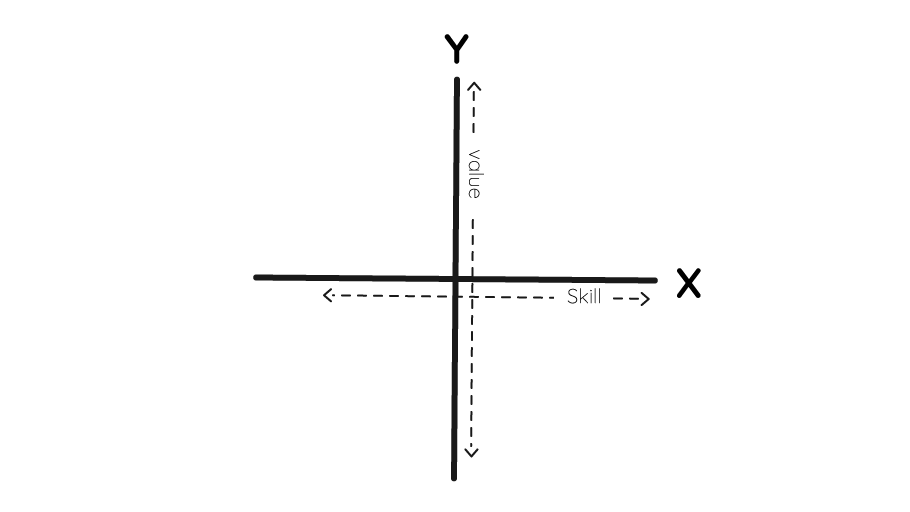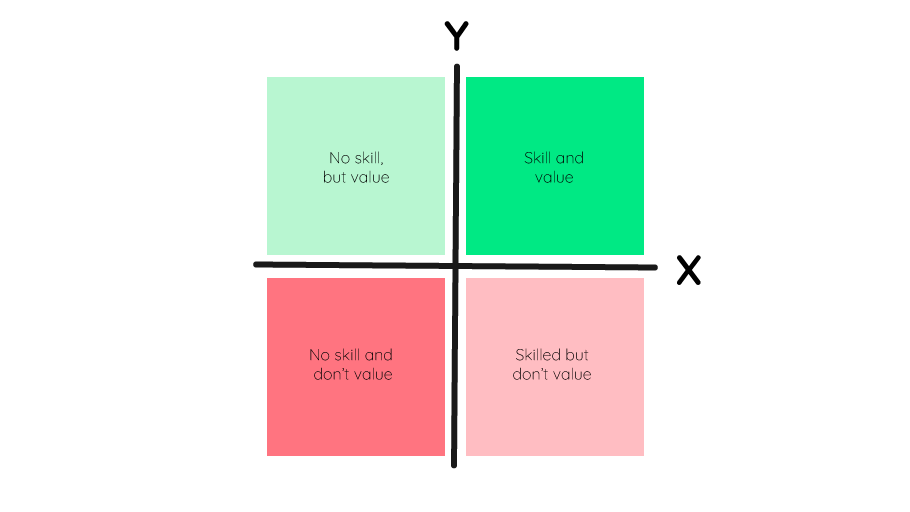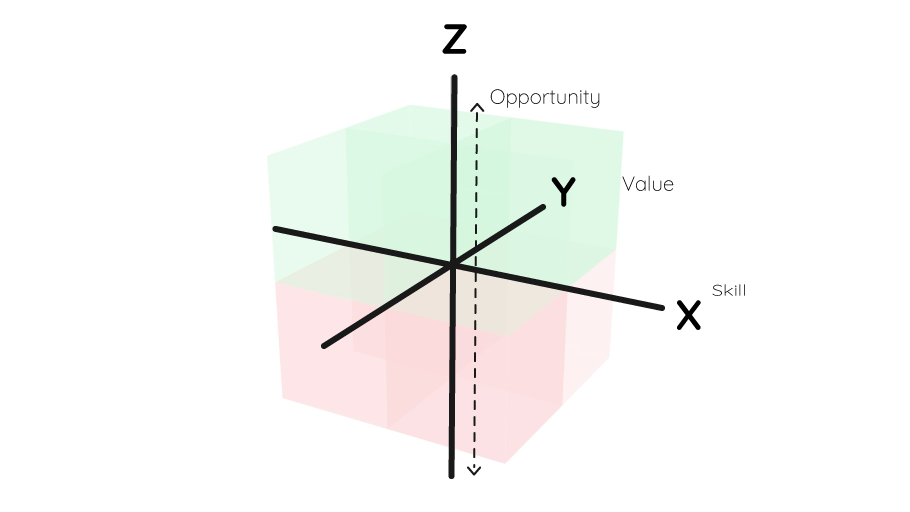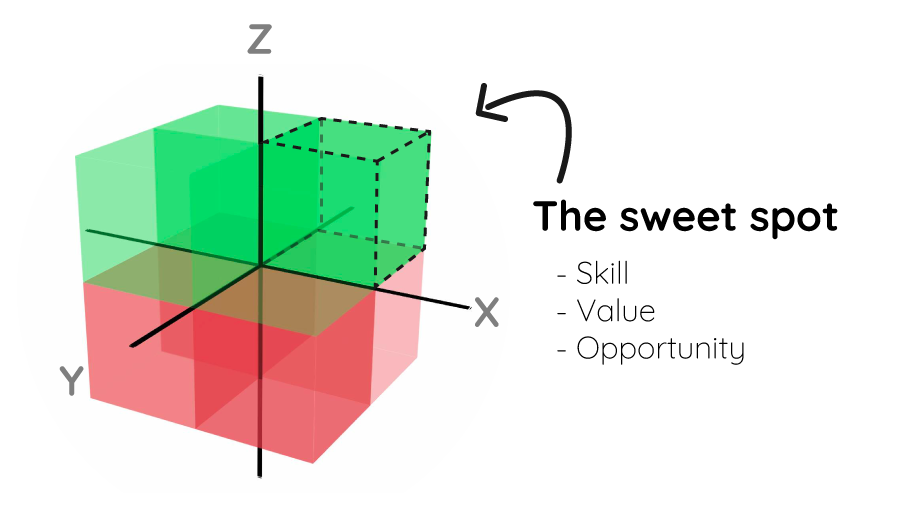
Choosing the correct career path for yourself is a big deal. Selecting the wrong career can be very costly in terms of time and money. Many people go years experimenting with a career only to find that what they pursued isn’t quite as enjoyable or satisfying as they once imagined.
It’s difficult though. How do you know you’ll enjoy a particular occupation when you have no prior experience in it at all? While I don’t think there’s a one-size-fits-all approach to identifying the best career for yourself, I do feel that the essence of picking a great career can be broken down to a few basic variables, and the more you take time to consider these variables upfront, the better career decision you can make. To help remember and conceptualize these variables I’d like to combine them in a visual model I’d like to call “The Career Cube.”
The Career Cube
I once attended a career preparation class in college that focused on helping students to choose the right career for themselves and it also covered different methods to achieve success upon entering a career. The way the class was formatted was that the professor would bring in various successful business leaders and entrepreneurs to come and speak about one aspect of preparing for and being successful in a career.
I remember one class lecture in particular that stuck with me, in which the lecturer discussed a simple 2-dimensional model for identifying if a career was right for you. I don’t recall this lecturer’s name unfortunately but I really appreciated the advice and feel it would be beneficial to share some thoughts on it.
The First Two Dimensions, Skill and Values
During the lecture, this business leader drew two intersecting horizontal and vertical lines which made up four equal quadrants. The lecturer described to us that the horizontal line, or x-axis, represented one’s skill level, and the vertical line, or y-axis, represented what you value, or have an interest in. He explained that these lines represented spectrums and further up you went on the y-axis, for example, that meant the more you valued a particular field. Reversely the more you went down the y-axis, the more disinterested you were. As you would then guess, the horizontal, or x-axis, represented the level of skill you had with a particular field. The more to the right you went the more skilled you were and the more left the more unskilled. This graph is depicted below:

This business leader’s advice was to pick a career that was in either the top-left or top-right quadrants, or in other words, something you were not necessarily currently skilled in but a career that you highly valued. The idea was that if you truly valued or had a deep interest in a career, that in and of itself would drive you to be successful, even if you didn’t yet have the skill set to do so. If you truly valued a particular field and were intrinsically motivated by it, the skills required for the position would eventually come. It’s much easier to teach a skill rather than to teach someone motivation.

When I first heard this I really liked the concept because of its simplicity. Although, after seeing a video a few years later entitled “Don’t Follow Your Passion,” by the Dirty Jobs host, Mike Rowe, I felt that there was one very important thing this model lacked, opportunity.
The Third Dimension, Opportunity
In this video, Mike Rowe talks about not pursuing your passion, but more, pursuing opportunity and then making that your passion. He gives the all-to-often example of singers who pursue their passion of becoming a famous musician only to find out that they either aren’t quite good enough to make it. Or they find out that there really isn’t much opportunity for them to make it big in the industry. Though there are a lot of people that are very talented and really value singing, or in other words, the top right quadrant of the 2D graph, this career path won’t work in the end because the opportunity in the field is so low.

Mike Rowe later shares an example of someone he met on one of his Dirty Jobs episodes who was in the toilet sanitation and septic tank business. This man became very successful and turned himself into a multi-millionaire because he pursued an opportunity in a field that not a lot of people would enjoy doing. While on Dirty Jobs, this man told Mike Rowe, “I looked to see where everyone else was headed, and then I went the opposite way. Then I got good at my work. Then I began to prosper. Then one day, I realized I was passionate about other people’s crap.”
To further illustrate this thought, I’d like to include some research done by E. M. Gray, who spent a portion of his life trying to identify which one attribute was shared by all successful people. In his essay, “The Common Denominator of Success” he writes, “The successful person has the habit of doing the things failures don’t like to do. They don’t like doing them either necessarily. But their disliking is subordinated to the strength of their purpose.”
Find Opportunity, or Create It
Now, I’m not saying to drop all your dreams and aspirations. After all, some people do achieve success in the exact field they value, even when there is not much opportunity. And having skills and interest in a particular field is indeed very important in a career decision. What I am saying is to be smarter about your career decision. There is a more intelligent way for you to think about what career to choose and first framing your choice against the question of “what industries or fields have the most opportunity,” might guide you in a better decision.
It’s important to note that opportunity isn’t always something identified, but can be something you create. As Pixar’s Ed Catmull puts it, “the best way to predict the future is to invent it.” One thing that really bothered me during tough times during my career was knowing that there were people on YouTube doing much simpler, sometimes mindless work and were being rewarded handsomely for it. This didn’t seem very fair to me. I had to go through years of college and was often doing very difficult work before I got to a place I truly enjoyed my career. Whether it’s fair or not, I made my decision to use my time educating and training myself while others were busy taking action and pursuing opportunities that they either found or created.
Striving to Find the Sweet Spot
So summing it all up, my advice is this: When thinking about what career you should choose, try and see if there is anything out there that lies in the space where opportunity, skill, and values all intersect.

There are a lot of career options out there and sometimes you’ll have to do a little digging. You may even have to even find and speak to a few people actually doing the thing you’re thinking of pursuing before knowing that it’s worth pursuing. In the end, it can be difficult to know for certain if a particular field will be satisfying for you. But if your decision is based on these three variables, and you really do your homework, you can have much more of an assurance that what you have decided will indeed be something that will be right for you.
Looking to set some career goals?
Start setting more effective, data-driven goals with the brightyear.io app today!